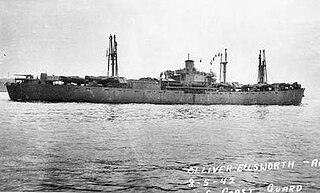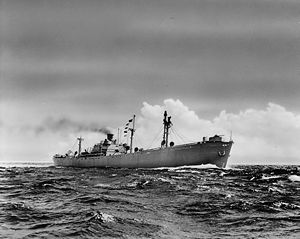
SS John W. Brown is a Liberty ship, one of two still operational and one of three preserved as museum ships. As a Liberty ship, she operated as a merchant ship of the United States Merchant Marine during World War II and later was a vocational high school training ship in New York City for many years. Now preserved, she is a museum ship and cruise ship berthed at Pier 13 in Baltimore Harbor in Maryland.

SS Patrick Henry was the first Liberty ship launched. It was built by the Bethlehem Shipbuilding Corporation at their Bethlehem-Fairfield Shipyard in Baltimore, Maryland. She was named after Patrick Henry, an American attorney, planter, and Founding Father as well as the first and sixth post-colonial Governor of Virginia, from 1776 to 1779 and 1784 to 1786.

USS Cebu (ARG-6) was a Luzon-class internal combustion engine repair ship that saw service in the United States Navy during World War II. Named after Cebu, an island in the Philippines, it was the second ship of the Navy to bear this name.
SS Benjamin Harrison was a Liberty ship built in the United States during World War II. She was named after Benjamin Harrison, an American planter and merchant, a revolutionary leader, and a Founding Father of the United States. She served a year from March 1942 to March 1943, when she was attacked and scuttled.

USS Mindanao (ARG-3) was a Luzon-class internal combustion engine repair ship in service with the United States Navy from 1943 to 1947. She was sunk as an artificial reef in 1980.
SS George Calvert was a Liberty ship built in the United States during World War II. She was named after George Calvert, an English politician and colonizer. Calvert took an interest in the British colonization of the Americas, becoming the proprietor of the Province of Avalon, the first sustained English settlement on the southeastern peninsula on the island of Newfoundland. He later sought a new royal charter to settle the region, which would become the state of Maryland.

SS Oliver Ellsworth was a Liberty ship built in the United States during World War II. She was named after Founding Father Oliver Ellsworth, an American lawyer, judge, politician, and diplomat. He was a framer of the United States Constitution, a United States senator from Connecticut, and the third Chief Justice of the United States.

The SS Gulfamerica was an American steam tanker built by Bethlehem-Fairfield Shipyards Inc, of Sparrow's Point, Maryland and completed in March 1942. She was operated by the Gulf Oil Company of New York City and homeported in Philadelphia.

SS Georgetown Victory was a Victory ship built for the War Shipping Administration late in World War II under the Emergency Shipbuilding program. She was a type VC2-S-AP2/WSAT cargo ship with the United States Maritime Commission (MCV) -"Victory"; hull number 653, shipyard number 1597 and built by Bethlehem Shipbuilding Corporation in Baltimore, Maryland, she was laid down on 8 March 1945. Georgetown Victory, named after Georgetown University, was launched from the Bethlehem-Fairfield shipyard at Baltimore on April 28, 1945 and completed on 22 May 1945.
SS Roger B. Taney was a Liberty ship built in the United States during World War II. She was named after Roger B. Taney, who was the fifth Chief Justice of the Supreme Court, holding that office from 1836 until his death in 1864. Prior to joining the Supreme Court, Taney served as the United States Attorney General and United States Secretary of the Treasury under President Andrew Jackson.
SS John Randolph was a Liberty ship built in the United States during World War II. She was named after John Randolph, a planter and a Congressman from Virginia who served in the House of Representatives at various times between 1799 and 1833 and the Senate from 1825 to 1827. He was also Minister to Russia under President Andrew Jackson in 1830.
SS Christopher Newport was a Liberty ship built in the United States during World War II. She was named after Christopher Newport, who was an English seaman and privateer. He is best known as the captain of Susan Constant, the largest of three ships which carried settlers for the Virginia Company, in 1607, on the way to found the settlement at Jamestown, in the Virginia Colony, which became the first permanent English settlement in North America. He was also in overall command of the other two ships on that initial voyage, in order of their size, Godspeed and Discovery.
SS John Witherspoon was a Liberty ship built in the United States during World War II. She was named after John Witherspoon, a Scottish-American Presbyterian minister and a Founding Father of the United States. Politically active, Witherspoon was a delegate from New Jersey to the Second Continental Congress and a signatory to the United States Declaration of Independence. Later, he signed the Articles of Confederation and supported ratification of the Constitution. In 1789 he was convening moderator of the First General Assembly of the Presbyterian Church in the United States of America.
SS Richard Bland was a Liberty ship built in the United States during World War II. She was named after Richard Bland, an American planter and statesman from Virginia. He served for many terms in the House of Burgesses, was a delegate to the Continental Congress in 1774 and 1775, and is considered a Founding Father of the United States.
SS Thomas Ruffin was a Liberty ship built in the United States during World War II. She was named after Thomas Ruffin, an American jurist and Justice of the North Carolina Supreme Court from 1829 to 1852 and again from 1858 to 1859. He was Chief Justice of that Court from 1833 to 1852.
SS John Carter Rose was a Liberty ship built in the United States during World War II. She was named after John Carter Rose, a United States circuit judge of the United States Court of Appeals for the Fourth Circuit and previously was a United States District Judge of the United States District Court for the District of Maryland.
SS Pierce Butler was a Liberty ship built in the United States during World War II. She was named after Pierce Butler, a South Carolina, rice planter, slaveholder, politician, an officer in the American Revolutionary War, and one of the Founding Fathers of the United States. He served as a state legislator, a member of the Congress of the Confederation, a delegate to the 1787 Constitutional Convention, and a member of the United States Senate.
SS James Caldwell was a Liberty ship built in the United States during World War II. She was named after James Caldwell, a Presbyterian minister who played a prominent part in the American Revolution. Caldwell was an active partisan on the side of the Patriots, and was known as the "Fighting Parson". He was killed on 24 November 1781, by an American sentry in Elizabethtown, New Jersey, when he refused to have a package inspected. The sentry, James Morgan, was hanged for murder on 29 January 1782 in Westfield, New Jersey, amid rumors that he had been bribed to kill the chaplain.
SS George Weems was a Liberty ship built in the United States during World War II. She was named after George Weems, who in 1828, established steamship travel on the Rappahannock River.
SS Will Rogers was a Liberty ship built in the United States during World War II. She was named after Will Rogers, an American stage and film actor, vaudeville performer, cowboy, humorist, newspaper columnist, and social commentator from Oklahoma.







